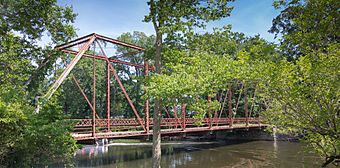Marantette Bridge facts for kids
Quick facts for kids |
|
|
Marantette Bridge
|
|
 |
|
| Location | Railroad St. over St. Joseph R., Mendon, Michigan |
|---|---|
| Area | less than one acre |
| Architect | Massillon Bridge Company |
| Architectural style | Pratt through truss bridge |
| NRHP reference No. | 01000708 |
| Added to NRHP | June 25, 2001 |
The Marantette Bridge, also called the Railroad Street Bridge, is a very old bridge in Mendon, Michigan. It crosses the St. Joseph River. This bridge is no longer used for cars. It was added to the National Register of Historic Places in 2001. This means it's an important historical site in the United States.
History of the Marantette Bridge
The area around the bridge has a long history. An early settler named Patrick Marantette came to Mendon in 1833. He managed a trading post near where the bridge is now.
The very first bridge over the St. Joseph River in this area was built in 1839. It was located a bit upstream from where the Marantette Bridge stands today.
In the late 1850s, a railroad company planned to build tracks through Mendon. Patrick Marantette then created a map for the land north of the river. This map included the street we now call Railroad Street. It seems there was no bridge at Railroad Street until 1873.
The bridge built in 1873 was replaced just three years later, in 1876. The Marantette Bridge we see today was likely built around the year 1900. It was constructed by a company called the Massillon Bridge Company from Massillon, Ohio. This bridge was used by cars and trucks until 1984, when it was closed.
What Does the Marantette Bridge Look Like?
The Marantette Bridge is a special kind of bridge called a Pratt through truss bridge. Imagine a giant metal frame that supports the bridge deck. That's what a truss bridge is! This one has eight main sections, or "panels," made of steel.
The bridge is about 141 feet long, which is like 14 school buses lined up end-to-end. It is 16 feet wide. The bridge rests on strong stone supports called abutments.
The part of the bridge where cars used to drive is made of wooden planks. These planks are now very old and damaged. They sit on top of steel beams. The top part of the bridge's metal frame is made of channels connected by flat metal plates.



